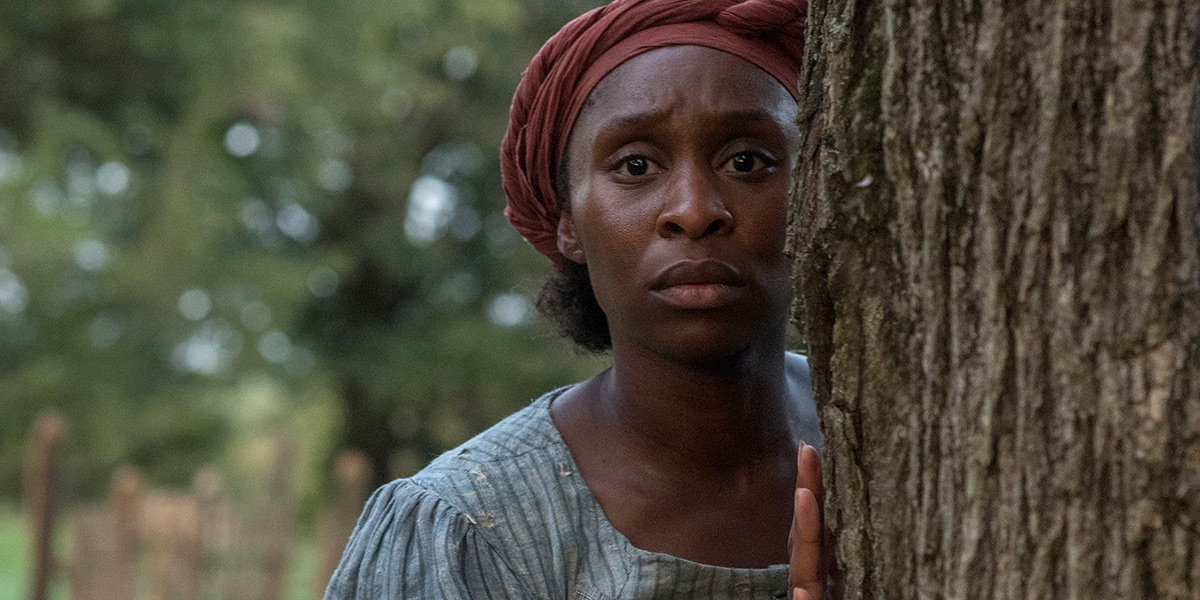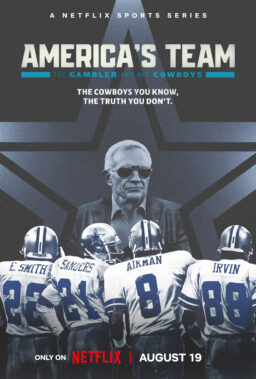Every year a film arrives about a famous white figure: Marie Curie, Winston Churchill, Queen Elizabeth II—yet there’s never been one about Harriet Tubman. In the eyes of white producers, the worth of Black heroes not in spandex lacks equal measure with their white counterparts. Until now. More superhero origin story than pure biopic, Kasi Lemmons’ “Harriet” charts the abolitionist from her first escape to freedom to Civil War spy in a formulaic but incredibly well-acted story.
“Harriet” begins on a gloomy day in Bucktown, Maryland 1848. A storm is coming, and the film’s heroine (Cynthia Erivo) lies on the grass, left in a trance by a vision. She’s had these hallucinations since her head was split open by her master, but today is different. Married, her husband Junyah (CJ McBath) is a free Black man, while she’s a slave—legally bound to the land and her white owners until she’s auctioned or dies. Sold down river—to the Deep South where a harsher brand of slavery existed—she runs away to the north.
Erivo—whose credits include “Widows” and the Broadway production of “The Color Purple”—catapults her star potential to greater heights in “Harriet.” Initially, she plays Tubman as wide-eyed, determined, and resourceful, yet casting downward eyes. When Tubman arrives in Philadelphia, Pennsylvania, she’s helped by the abolitionists William Still (Leslie Odom Jr.) and Marie Buchanan (Janelle Monáe). Within “Harriet,” Odom is confined to a one-note character—solely there to tell her the impossible odds she faces. On the other hand, Marie might be the more compelling character to even Tubman. Monáe radiates on screen, playing an intelligent self-assured free-born Black woman. A difficult task for Eviro—the scenes featuring both women are often imbalanced in favor of her co-star—Tubman as a character and mythology requires nurturing and growth throughout the biopic. By the film’s conclusion, Eviro’s Harriet fully transforms. Her eyes aren’t sealed to the ground—she’s peering upward into the eyes of friends and enemies without hesitation.
Historically, Tubman also suffered from seizures resulting from a two-pound metal weight fracturing her skull. Her fits, she claimed, gave her visions from God. Lemmons incorporates these beliefs. The film’s cinematography, dependent upon blue and white hues during her premonitions and for night shots, is mystical, dreamy. But rarely are the visions religious in tone. Instead, Terence Blanchard’s oddly fitting piano score intimates a supernatural or ghostly element that runs counter to the film’s Godly message. Nevertheless, the music of slave hymns as coded messages for escape is well-employed and historically accurate in “Harriet.”
Throughout “Harriet,” Tubman’s former-master Gideon (an acidic Joe Alwyn) hunts for her. And while he’s violently racist, “Harriet” might be the least visceral slavery narrative ever filmed. There are no scenes of beatings, lynchings, or retribution—a vast difference from “12 Years A Slave,” “Amistad” and “Glory.” Instead, the sense of suspense stems from the threat of danger: What consequences await any slave whether they’re caught or remain undertow? Lemmons intimated during the film’s Q&A that she wanted to make a freedom film, not a slavery movie. The former is refreshing; however, the freedom component runs repetitive. Tubman increasingly takes trips down South to free her family—guiding them on the Underground Railroad. The segments routinely follow the same pattern: Tubman ignoring the warnings about returning South, her coaxing her family into escaping to the North, and the visions she has while they’re chased. These conventions are repeated several times—making each rotation less adventurous.
Paul Tazewell’s unique costumes for Tubman are surprisingly androgynous; she wears a sailor’s outfit, a top hat and blazer, and ten-gallon hats. Soon, she becomes mythologized—Southern whites fear her as “Moses.” “You will follow me,” she says. The cliche of masculinity and strength—slave owners initially assume her identity to be a man, isn’t massaged extensively here. But it should be, considering Tumban’s title as not just a Black hero, but an idol to Black women especially. Even with the addition of a nefariousness Black slave tracker (the electric, Omar J. Dorsey), “Harriet” remains standard as a biopic. While the mere existence of a Tubman movie is radical and uplifting—and at various points “Harriet” is truly uplifting—Lemmons’ film isn’t more than a star vehicle for Erivo. Which isn’t a failure, but it flies far beneath the heights of what could have been.

“Personal Shopper” filmmaker Olivier Assayas returns with “Wasp Network,” a historical spy film following Cuban dissenters during the ’90s in Florida. Assayas’ script initially follows René (Olivier Assayas), Olga (Penélope Cruz), and their daughter Irma (Osdeymi Pastrana Miranda). René, who worked as an instructional pilot, in 1990 successfully hijacks a plane to defect to America. Another defector: Juan Pablo (Wagner Moura) soon joins him too. Both René and Juan become pilots for the CANF (Cuban American National Foundation) to assist defecting Cubans and hasten the collapse of Castro’s regime. Both infiltrate CANF, rising up the ranks, with Juan Pablo graduating to a lavish lifestyle and marrying the attractive Ana Margarita (Ana de Armas).
Assayas, while filming “Wasp Network,” was given the rare opportunity to film in Cuba. The flights René and Juan Pablo take over the island offer them unadulterated views of the country. The whole blockade, they explain, is a type of brinkmanship, nourished more by intimidation and threats than keeping planes out of respective air spaces. Assayas’ aerial shots, sweeping over Havana’s bustling metropolitan grid, offer the most vibrant and modern photography of the island nation on film. If only the editing and story followed the same beautiful course.
Tonally, “Wasp Network” is jumbled. As Assayas unravels the mystery behind René and Juan Pablo, he introduces other characters and historical figures, such as the terrorist Luis Posada Carriles (Tony Plano) and Gerardo Hernandez (Gael García Bernal), director of Wasp Network. René’s soon realizes CANF’s moral ambiguities. And with the CIA investigating him, “Wasp Network” shifts into a spy thriller as the narrative twists and turns. However, Assayas doesn’t remain within the conventionalities of a spy thriller, much to the film’s detriment. When shocking reveal after reveal arrives, they’re accompanied by voiceovers and an upbeat score that points toward a comedy. The result is jarring.
The editing and story also lack direction, leaving several narrative gaps. René is a pilot, but then for a period becomes a gardener, and then a pilot again. He also switches allegiances from CNAF to PUND, and then back to CNAF. These segments are intercut with events surrounding other characters like Olga, Gerardo, and Juan Pablo without any rising action—meandering to a halt. Few of the actors standout because Assayas rapidly oscillates between their timelines, building no pathos or connection to them. In fact, the film takes place over the course of eight years, blurring through at an incomprehensible pace. Only Cruz, her character Olga left behind by René to fend for herself, leaves a mark. When the truth about her husband is revealed to her, Cruz’s non-verbal acting prevails, as her emotions fall over her face like rain.
“Wasp Network” culminates when a young El Salvadorian is hired to execute a terrorist attack in Cuba. Assayas meticulously charts the time of the attacks through time stamps, but initially the events appear inconsequential to the film’s overall narrative arc. Such is Assayas holding onto every kernel of information, creating too much noise in the service of meaningless ends. “Wasp Network”‘s twists lack coherency, creating a dull, slogging 125 minutes. By the time all of the identities are revealed, they’re inconsequential, making “Wasp Network” as devoid of believability as the real-life events, and as exciting as reading the encyclopedia to find out how.

Vastly different from any movie at TIFF, and certainly leagues away from the two historical dramas reviewed above, Jason Lei Howden’s “Guns Akimbo” is bonkers.
“Guns Akimbo” follows Miles (Daniel Radcliffe)—a coder, troll, and keyboard warrior, living a miserable life. Still recovering from a recent breakup with his ex-girlfriend Nova (Natasha Liu Bordizzo), he works at a dead-end job with a jerk bodybuilding boss. However, a new phenomenon has swept across the nation: SKISM—a game where two people are pitted against each other in an actual life-and-death fight. Streamed across the nation, the Gladiatorial matches are captured through drones and have legions of fans and even commentators. Miles stumbles upon the game, invading its message boards and trashing the practice until SKISM comes for him. They drug the coder and screw two guns to his hands. A twerpy geek, he must fight to live. A tall task when his first opponent is Nix (Samara Weaving), a bubbly Harley Quinn-type killing machine.
Howden’s action film employs slick camerawork and loud “Street Fighter”-inspired graphics. Using a plethora of canted angles and 360 slow motion shots—he arrives at a mixture of exciting and sometimes trite results.“Guns Akimbo” unravels several video game narrative conventions—mostly through Radcliffe’s feigned voiceovers. “This isn’t a love story,” he claims, and the girl isn’t a prize to be won. Radcliffe—whose post-Potter career includes oddball flicks like “Swiss Army Man” and “Horns,” finally becomes an action star under the most ironic of circumstances. Because while “Guns Akimbo” gluttonously feeds off of car chases and gun fights—it also features cheap humor, such as the very predicament of doing anything with guns screwed to your hands: eating, using your phone, putting on your pants, or even using the bathroom. In one instance, Miles meets a homeless crackhead who gives him an eight-month old hotdog that he excruciatingly eats off an alleyway’s pavement by a used condom.
These death matches and SKISM are run by the heavily tattooed, shadowy, and psychotic Riktor (an inspired Ned Dennehy, swinging for the fences) who takes Nova hostage to blackmail Miles into battling Nix. One major plot hole exists—specifically the drone surveillance used to live stream the fights, when Howden’s action movie culminates with a loud and bloody end-level fight that sees Radcliffe answer the question of what would happen if his roles were less idiosyncratic. The answer? He’d be just as amazing, and “Gun Akimbo” for all its outlandishness, is a spectacularly fun and exciting time whenever the needle drops and Weaving owns her badass, gun-wielding image.












